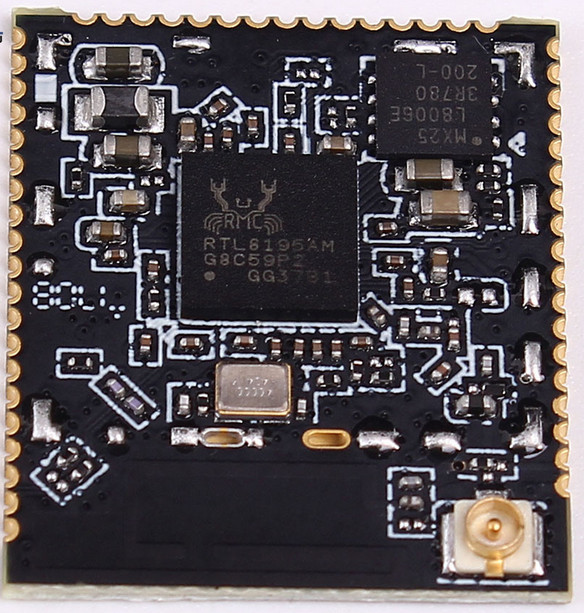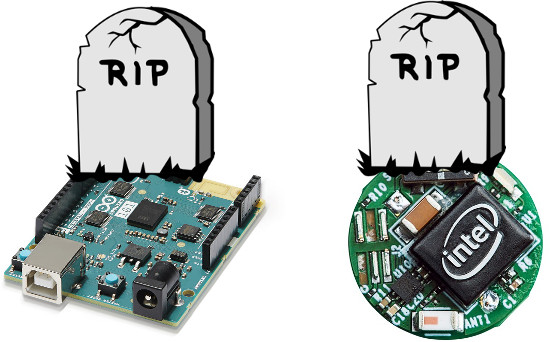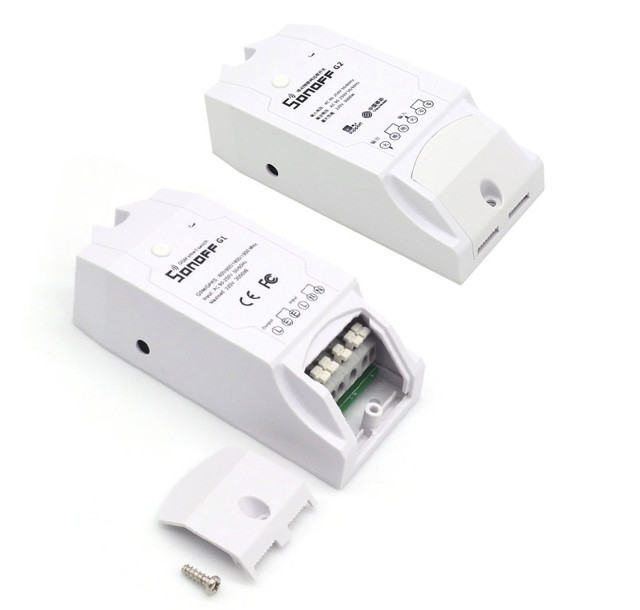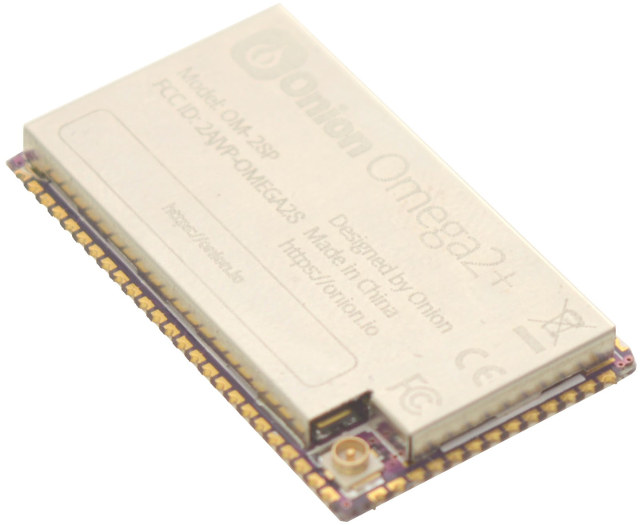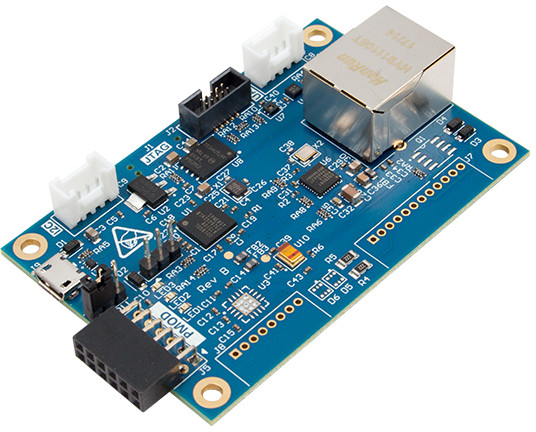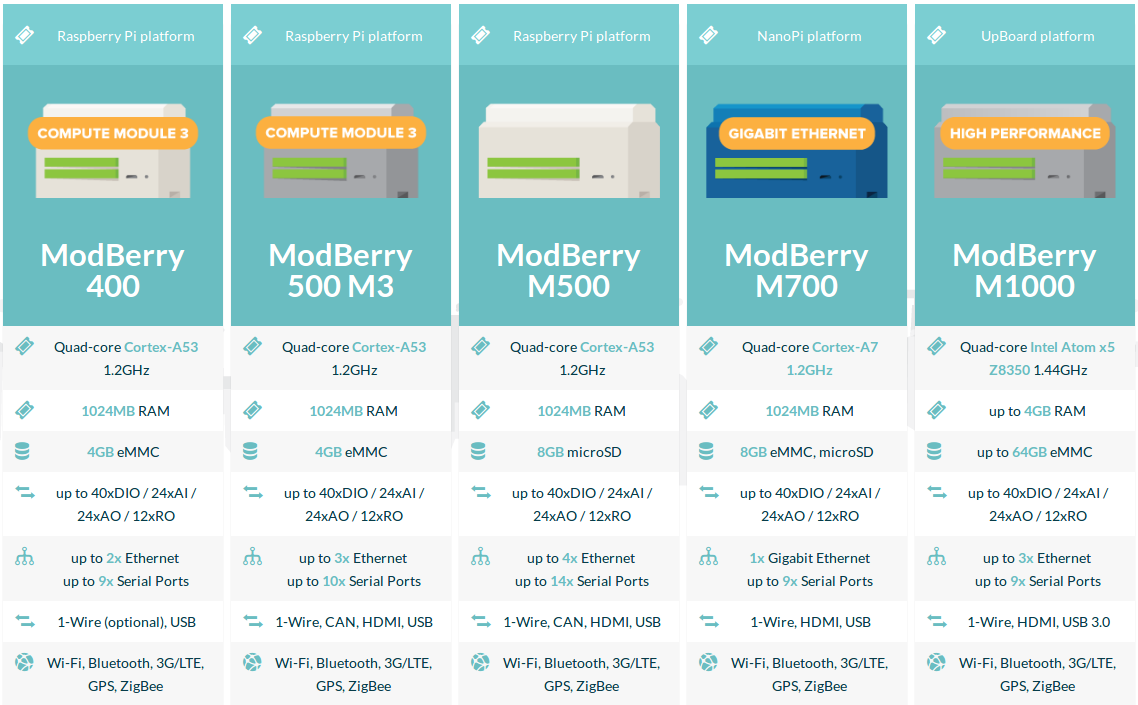Last year, Realtek Ameba IoT SoCs and development kits launched with boards such as Ameba Arduino, and later, the family got some buzz thanks to $2 RTL8710AF modules like Pine64 Padi IoT stamp, which looked competitive priced against ESP8266 SoC, and featuring an ARM Cortex-M3 core. Back to 2017, ESP8266 appears to still be the preferred platform for makers, and the community around Reatek Ameba processor is relatively small, but maybe the solutions are being integrated into commercial products rather than hobbyists project. Today, as I browsed the web, I noticed that are also some Realtek RTL8195AM module with WiFi, and NFC starting with an “Realtek Ameba-RTL8195AM WiFi & NFC Module” I first found on DFrobot for $15 per unit, but after spending a bit more time searching, I ended finding what looks like the same model for $8.99 including shipping on IC Station. RTL8195AM module (MJIOT-AMB-02) specifications: SoC – […]
Intel Curie Module, Arduino 101 Board Are Being Discontinued (Too)
Intel seems to have completely given up on its efforts to bring products specific to the Internet of Things. After discontinuing Intel Edison, Galileo and Joule boards & modules last month, forcing companies to look for alternatives, the company has now issued product discontinuance / end-of-life notices for Intel Curie Module and Arduino 101 board, itself based on the Curie module. The two product change notification notice can be found below for: Select Intel Curie Module Products – PDF Select Intel Arduino 101 Products – PDF The use of the word “Select” would normally mean some versions of the module and board won’t be affected, but I fail to see which ones here, as AFAIK there’s only one Arduino 101 board, and two variants of Curie modules, all three to be discontinued. Arduino 101 will be phased out faster with the following milestones: July 17, 2017 – Product Discontinuance Program […]
Sonoff G1 AC Powered Smart Power Switch Works Over 2G GSM/GPRS
Today, I’ve searched for AC powered wireless switched similar to Sonoff devices, but with ESP32 instead in order to get WiFi and Bluetooth, since the latter is better to use with a battery powered buttons. I did find a DC powered board, but no AC powered ones yet. However, as I visited ITEAD website to check if they had anything of the sort, I discovered they had a new model called Sonoff G1, similar to Sonoff TH16, but instead of using WiFi, you can use 2G GSM/GPRS to control the switch remotely. Sonoff G1 specifications: Wireless Module – ST86 quad band GSM/GPRS module GSM/GPRS connectivity GSM850, EGSM900, DCS1800 and PCS1900 MHz support GPRS multi-slot class 10, GPRS mobile station class B 1.8V, 3V SIM card slot Transmit power: Class 4 (2W): GSM850, EGSM900; Class 1 (1W): DCS1800, PCS1900 Relay – Up to 16A (3000 Watts max) Terminals – 6 terminals […]
Onion Omega2S and Omega2S+ Linux WiFi Modules Launched for OEMs
Onion Omega2 and Omega2+ are tiny WiFi IoT development boards powered by Mediatek MT7688 MIPS processor running LEDE – OpenWrt fork – that sold for just $5 and up in Kickstarter, but are now selling for $7.50 and $9 respectively. The board also support various add-on boards, and a great for evaluation and various projects. But they may not be ideal for people who want to integrate the technology into their products, and that’s why the company have just launched Omega2S and Omega2S+ with about the same specifications, but in a package more suitable to be integrated into products for mass production. Onion Omega2S/2S+ specifications: WiSoC – Mediatek MT7688 MIPS processor @ 580 MHz System Memory / Storage Omega2S – 64MB DDR2 / 16MB flash Omega2S+ – 128MB DDR2 / 32 MB flash Connectivity – 802.11 b/g/n WiFi with u.FL antenna connector Baseboard Interface – Half holes (aka castellated holes) […]
Renesas S5D9 IoT Fast Prototyping Board Combines Cortex M4F MCU, Sensors, and Ethernet
Renesas S5D9 IoT Fast Prototyping board is a board designed – as its name implies – for the Internet of Things, with the company’s Synergy S5D9 ARM Cortex-M4F micro-controller, various sensors, various I/Os including protected digital inputs and outputs, and Ethernet for network connectivity instead of a Bluetooth or/and WiFi module. Renesas S5D9 board specifications: MCU – Renesas Synergy S5D9 ARM Cortex M4F MCU @120MHz with 2MB flash and 640KB SDRAM Storage – 256Mbits (32MB) QSPI NOR flash Connectivity – 1x 10/100Mbps Ethernet (RJ45) USB – 1x micro USB Full Speed port Sensors Bosch BMC150 6-Axis sensor (digital compass) AMS ENS210 environmental sensor for temperature and humidity data TE Connectivity MS5637-02BA03 barometric pressure sensor Knowles SPU0414HR5H-SB amplified SiSonic microphone Expansion 1x PMOD connector (SPI) 2x Grove Connectors (UART, I2C, GPIO) 2x Protected Digital Input (5.1V to 24V) + 2x Buffered Digital Output (up to 1A) via Molex 12 position header […]
ModBerry Industrial Automation Controllers Leverage Raspberry Pi, FriendlyELEC, and AAEON Boards and Modules
TECHBASE’s ModBerry Linux based industrial controllers have been around since 2014 with their first model being ModBerry 500 powered by a Raspberry Pi compute module. Over the years, the company has kept adding new ModBerry controllers with now an interesting choice of Raspberry Pi 3 board or compute module, FriendlyELEC’s NanoPi M1 Plus board, or Intel Atom x5 based AAEON’s UP board. All programmable automation controllers (PAC) runs Linux 4.0 or greater, with Debian or Ubuntu Core rootfs including ready tools and pre-compiled packs including C/C++, JAVA, SQL, PHP, SSH, and VPN support. The firmware is upgradeable over the air, and the controllers can run the company’s iMod control software and interface with iModCloud cloud computing service for telemetry, remote control and data sharing. Typical uses include C-L-V functions with conversion to collect and transmit data over communication interfaces, logging via iModCloud or a SCADA, and visualization via a web […]
Bluetooth Low Energy Now Supports Mesh Networking for the Internet of Things
The Bluetooth Special Interest Group (SIG) has announced support for mesh networking for BLE, which enables many-to-many (m:m) device communications, and is optimized for large scale device networks for building automation, sensor networks, asset tracking solutions, and other IoT solutions where up to thousands of devices need to reliably and securely communicate with one another. The standard actually specifies 32,767 unicast addresses per mesh network, but that number of nodes is not achievable right now. Mesh networking works with Bluetooth Low Energy and is compatible with version 4.0 and higher of the specifications. It requires SDK support for the GAP Broadcaster and Observer roles to both advertise and scan for advertising packets, and the FAQ claims Mesh Networking does not require extra power, and the devices only need to wake up at least once every four days or when they have data to transmit. Mobile apps connecting to mesh networking products […]
Office, Factory, Business Model, and Ambitious Plans of Shenzhen Xunlong Software, Orange Pi Maker
Parts of the article have been updated after Steven Zhao update at the end. Since Steven Zhao is the only one contact person at Shenzhen Xunlong Software, the maker of Orange Pi boards, and the company appears to be focusing on hardware development more than on software and documentation, so at one point in time, people were speculating that it could be one person operation 🙂 Last year, Steven told us there were over 10 persons working in the office. But hey, photos, or it’s fake! We now have a definite proof as Renaud Coustellier visited Steven Zhao in his Shenzhen Offices, and published a report on Minimachines (in French). I’ll provide a summary below, but visit Minimachines website, if you want the full story and more pictures. First, Shenzhen Xunlong rented a floor, or part of it, in one of the many Shenzhen office buildings, and engineers are working […]


